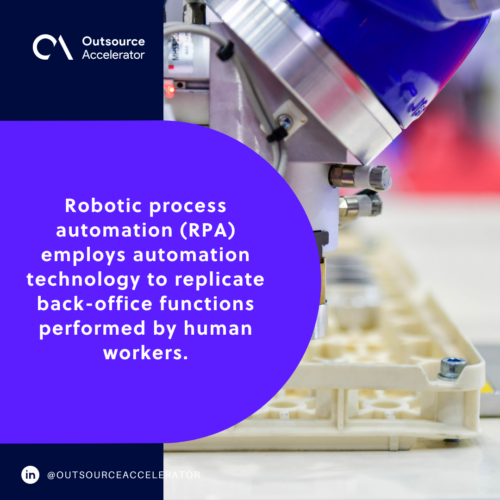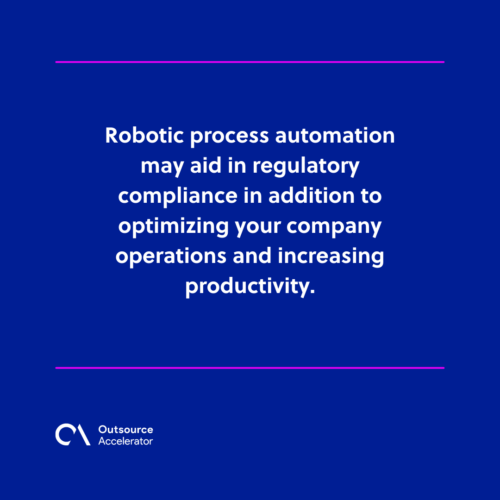Robotic process automation 101: Everything you need to know

As businesses develop and evolve, so do their processes. It also becomes increasingly challenging to manage all activities that must be accomplished regularly. Automation can streamline and manage these activities.
Organizations may save time and money while enhancing the quality of their goods or services by removing unnecessary steps, minimizing errors, and increasing productivity.
As such, robotic process automation may be a game changer in today’s fast-paced business environment.
This article discusses everything you know about robotic process automation — from its definition to its application — to the types and benefits of utilizing it.
What is robotic process automation (RPA)?
Robotic process automation (RPA) employs automation technology to replicate back-office functions performed by human workers.
The term “robot” refers to software robots that operate on a real or virtual system. By connecting APIs and user interface (UI) interactions, RPA combines and executes mundane tasks across business and productivity apps.
Further, robotic process automation solutions completely offer a self-support execution of various tasks and transactions from customer service — to general departments.
Datamatics uses these technologies to power its integrated platforms.

3 types of robotic process automation
Here are the three types of robotic process automation:
Attended RPA
Attended robotic process automation refers to software robots that work alongside human workers to augment their productivity.
In this type of RPA, the robot is triggered by the user to perform a certain task, and the user can interact with the robot as needed.
For instance, an attended RPA bot can analyze customer data to recommend products or services based on their purchase history in a customer service scenario.
Meanwhile, the human customer service representative can then engage with the customer to discuss the recommendation and provide additional information.
Unattended RPA
Unattended robotic process automation refers to software robots that work autonomously and do not require human intervention.
This is best suited for tasks that are repetitive and do not require human decision-making, such as data entry or invoice processing.
Hybrid RPA
Hybrid robotic process automation is a variety of attended and unattended RPA. In this type of robotic process automation, the robot can work alongside human workers or work autonomously depending on the task at hand.
Additionally, hybrid RPA is best suited for tasks requiring human and robot interaction, such as data analysis or report generation.
Application of robotic process automation
The most common industrial uses of robotic process automation are in finance and human resources.
To explain better, here are further details:
Finance
In finance organizations, robotic process automation can automate repetitive tasks such as data entry or reconciliations. It frees up employees’ time for more important work.
Human resources
HR leaders often struggle with hiring new talent because they must invest significant time reviewing resumes and conducting interviews before making offers to candidates.
With robotic process automation integrated into your recruiting process from day one, you can eliminate much of this wasted effort.
RPA then resumes screening processes so only qualified applicants make it through to the interview stage, where humans can take over again.
Benefits of robotic process automation
The advantages of using robotic process automation in your company are as follows:
Improved client services
Numerous customer inquiries can be handled simultaneously by robotic process automation. Additionally, it can produce receipts, manage payment refunds, and update customer information.
For instance, an automated bot may be built to handle client calls requesting an account adjustment rather than requiring a human employee to perform it by hand.
Robotic process automation may also assist in decreasing the amount of time spent on tedious jobs by replacing boring operations like:
- Making bills for clients
- Generating invoices
Compliance with regulatory requirements
Robotic process automation may aid in regulatory compliance in addition to optimizing your company operations and increasing productivity.
Here are a few instances of how RPA can assist your company in meeting regulatory requirements:
- Data security – may be ensured using robotic process automation systems to track and audit user access to sensitive information. This guarantees that only authorized individuals may access specific information or instantly report questionable activities.
- Respecting privacy rules – RPA systems may be set up such that companies only get the minimal amount of personally identifiable data necessary to comply with the law.

Employee productivity
Robotic process automation can also improve employee productivity in two ways:
- Improved decision-making – automation allows businesses to make decisions faster than ever before by eliminating human error and bias. This positively leads to better outcomes for both customers and employees alike.
- Better use of resources – when you remove repetitive tasks from your workforce’s workloads, they will have more time on their hands. This results in a greater focus on other things like customer service or product development.
Robotic process automation revolutionizes business processes
Overall, robotic process automation revolutionizes business processes — ultimately saving companies time, energy, and money while improving customer experience.
The technology uses existing systems within an organization, such as ERP or CRM software, then utilizes machine learning algorithms to learn from past customer interactions. As a result, employees can complete tasks more efficiently than humans ever could on their own.







 Independent
Independent




